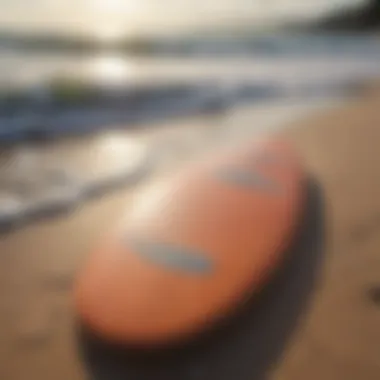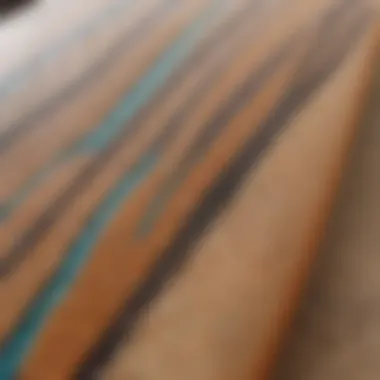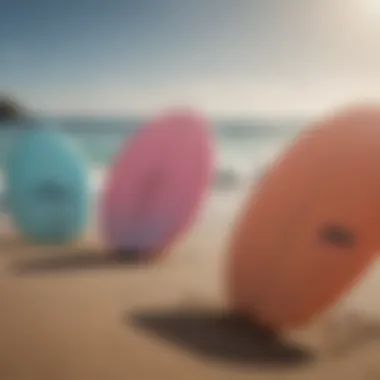The Complete Guide to Soft Top Skimboards


Intro
Soft top skimboards have carved a niche in the world of aquatic sports, drawing attention from both novice enthusiasts and experienced riders alike. These boards, renowned for their forgiving surface and buoyancy, are an important gateway into the dynamic realm of skimboarding. As riders glide across the coast, navigating between the waves and the shore, the soft top provides an element of comfort that is particularly beneficial for those just starting.
The design of these skimboards not only addresses the needs of beginners but also caters to seasoned skimmers looking for versatility and ease of use. This guide aims to break down the essentials of soft top skimboards, illustrating their unique construction features, advantages, and considerations when choosing the right board. Whether you're out to test the waters or refine your skills, understanding what soft top skimboards offer is paramount.
In the sections below, we will explore different surfboarding techniques that enhance performance, maintenance tips to keep your board in shape, suitable surfing destinations, and importantly, gear and equipment that complement your skimboarding experience. Let's dive into the depths of soft top skimboards, unraveling the methods, care, and tools that help elevate your ride.
Understanding Soft Top Skimboards
Skimboarding, a sport that dances between the lines of surfing and inland skating, has taken many enthusiasts on a wild ride of thrill and fun. Among various options, soft top skimboards shine as a user-friendly choice, particularly for beginners. They have features and qualities that stand out not only for their construction but for performance as well. Understanding soft top skimboards is essential, as it arms you with knowledge on their benefits, design aspects, and why they can be seen as a perfect entry point for novices and a capable ride for seasoned skimmers.
Definition and Characteristics
Soft top skimboards are designed with safety and ease of use in mind. They typically feature a foam top, giving them a softer feel compared to harder boards. This design helps in softening the blow if a rider falls, making it less daunting for newcomers.
Materials Used in Construction
-#### Foam Core A foam core is the heart of many soft top skimboards. This material is critical for buoyancy and stability. The lightweight nature of foam allows the skimboard to float better in water, making it remarkably easier for beginners to ride the waves. This leads to a more enjoyable experience sans unnecessary struggles. However, foam cores can be prone to dings if not handled carefully.
-#### EVA Decking Ethylene Vinyl Acetate (EVA) decking adds a layer of comfort and grip. Known for its cushioning, EVA ensures that riders can find their footing without slipping off too easily. This quality is especially beneficial for those just dipping their toes into skimboarding. Yet, it's worth noting that EVA can wear down over time, especially with intense use on abrasive surfaces.
-#### Fiberglass Components Fiberglass enhances the durability of soft top skimboards, creating a sturdy board that can withstand rough conditions. This choice also contributes to the board’s flex and responsiveness, important features for riders looking to perform tricks. While they can handle more impact than purely foam boards, fiberglass can increase the weight, affecting how easy it is to carry.
Design Variations
-#### Different Shapes The shape of a skimboard can greatly influence its performance. Squarer noses or wider tails allow for better stability while riding, making it simpler for new skimmers to balance themselves. On the other hand, more streamlined designs offer agility and tricks, catering to those who want to show off their skills. The diversity in shapes means skimmers can find what best fits their riding style and preferred conditions.
-#### Size Considerations Choosing the right size is vital for optimal performance. Bigger boards might be better for beginners, providing a larger surface area and greater stability. However, seasoned riders may wish to opt for smaller boards that enhance maneuverability. Size ultimately affects buoyancy and control, making it a crucial factor when selecting a board.
-#### Graphic Options Soft top skimboards come in many designs, often adorned with vibrant graphics that appeal to personal preferences. These aesthetic elements do more than please the eye; they can also reflect a skimmer's personality and style. A visually striking skimboard can stand out on the beach, offering not just a ride but a way to express individuality.
Benefits of Soft Top Skimboards
Soft top skimboards bring to the table an array of advantages that cater especially to both novice and seasoned riders. As skimboarding grows in popularity, understanding these benefits becomes vital for anyone looking to dive into this exhilarating sport. They're not just foam boards for fun; they serve specific purposes that enhance the experience of riding the waves.
Safety Features
Soft Surface Impact
Soft surface impact is one of the key advantages of using soft top skimboards. Unlike traditional wooden or fiberglass boards, the cushioned surface of these boards significantly reduces the chances of injury during falls. This plush layer is like a safety net, softening the blow if a rider takes a tumble. This characteristic makes soft top skimboards particularly appealing for beginners. The ability to fall with less risk can provide much-needed peace of mind for those just starting out on the water. A unique aspect of this feature lies in its innovation: many manufacturers now blend comfort with performance, allowing riders to focus on improving skills without the fear of harsh impacts.
User-Friendly Design
User-friendly design goes hand in hand with the advantages of safety, making soft top skimboards an appealing choice. These boards are typically lightweight, which means they are easy to carry from the car to the beach. The intuitive design also tends to include wider noses and tails, promoting stability on the water. The simpler the board, the easier it is for newcomers to grasp the basics of skimboarding. This straightforward approach to design allows even those unfamiliar with riding to jump right in. An essential benefit here is that a user-friendly design invites more people to participate in skimboarding, expanding the community and the sport itself.
Beginner-Friendly Attributes
Stability on Water
Stability on water is paramount when it comes to learning any sport, and soft top skimboards excel in this regard. The wider base and buoyant foam core grant greater balance while gliding or boarding. This characteristic ensures that learners can focus on mastering their stance rather than battling the board's stability. The unique feature of having a stable platform allows beginners to find their footing faster, leading to increased confidence. The notion that stability breeds adventure is pivotal; once a rider feels comfortable, they are more likely to explore new techniques and tricks.
Easy Handling
Easy handling is crucial for making skimboarding an enjoyable experience. Soft top skimboards are typically engineered to be lightweight, allowing riders to maneuver more fluidly in the water. This responsiveness attributes a sense of freedom while boarding. With the added benefit of softer edges, riders experience less friction and learn quicker how to slice through the waves. This lightweight nature makes them optimal for all riders, particularly young enthusiasts who might struggle with heavier boards. A drawback, perhaps, could be that very lightweight boards might be less suited for high-impact tricks, but for beginners, this feature is ideal.
Durability and Maintenance
Resistance to Damage
Resistance to damage plays an essential part in the value of soft top skimboards. Manufactured from sturdy materials, these boards withstand the rigors of lake or ocean use. They smartly combine durability with flexibility, allowing for bends and impacts without cracking. This ability to resist damage ensures that riders don’t have to frequently replace their boards, making soft tops a practical investment for those wanting to skim for extended periods. Although some may argue that they could incur scratches over time, this usually affects the aesthetics rather than the performance.


Simple Care Instructions
Simple care instructions make maintaining soft top skimboards a breeze, especially for novices overwhelmed by complex maintenance routines. A typical maintenance routine involves rinsing the board after use, storing it in a shaded area, and avoiding extreme temperatures. These straightforward care practices extend the life of the board, ensuring it remains in top condition for daily use. An appealing aspect of simple care is that it encourages more enthusiastic participation since users feel less burdened by upkeep. On the downside, neglecting basic cleaning could lead to mold or mildew, which is easily avoidable but crucial for the longevity of the boards.
"Soft top skimboards are the perfect gateway into the world of skimboarding, providing safety, ease of use, and durable design that transforms the learning experience into a thrilling adventure."
In summary, the myriad benefits of soft top skimboards promote safety, encourage beginners to access the sport easily, and contribute long-term viability through durability and low maintenance. Understanding these factors is crucial for anyone looking to understand how to truly enjoy their time on the water.
Choosing the Right Soft Top Skimboard
Choosing the right soft top skimboard isn't just about picking something that looks cool; it sets the stage for your entire experience on the water. Different skill levels, board sizes, and budgets demand careful consideration. The right skimboard can enhance your performance, making it vital to understand what options fit best with your needs and preferences. It’s a big ol’ puzzle, and getting the pieces correct leads to a smoother ride and more fun on those waves.
Skill Level Considerations
Beginner
For newcomers to skimboarding, a soft top board is like a friendly handshake from the ocean. Beginners often face apprehension, but these boards offer crucial stability and a forgiving surface. The key characteristic of beginner boards is their larger size, which helps with balance. This design gives novices the chance to build confidence in their skills, making it a popular choice amid the rookie crowd. The soft surface minimizes the fear of bumps and falls as riders learn basic techniques.
Advantages include a smoother learning curve, yet there are disadvantages too. These boards might lack the responsiveness desired when riders start to progress, potentially hampering the transition to more advanced maneuvers.
Intermediate
Once you’ve figured out the rhythm of the waves and how to catch them, it's time for something a little more challenging. Intermediate boards often have a balance between size and maneuverability. The key strength here is versatility. They're designed to accommodate riders who know the ropes but aren't quite ready for the extreme tricks.
These boards often incorporate additional features such as slight rocker for improved control, leaving room for improvement while still being fun to ride. One challenge with intermediate boards is that they sometimes demand more effort in balancing, which could frustrate some riders still honing their skills.
Advanced
Advanced riders are like musicians who are ready to add complexity to their tunes. They need boards that react instantly to movements and offer precision and performance. The defining characteristic of an advanced board is often its reduced size and sleek design, which allows for sharper turns and better tricks.
These boards provide thrill but can also come with a steeper learning curve. While it offers incredible performance, a misstep can lead for a hard landing. Therefore, this choice is best suited for those confident in their skills.
Board Size and Weight
User Weight Recommendations
Weight is a vital aspect when selecting a skimboard. Boards are designed for specific weight ranges, affecting how well they perform on the water. This characteristic is crucial because a board that’s too small for a rider’s weight could end up lacking in buoyancy, causing it to sink instead of glide.
For most beginners, following a guideline based on one’s weight helps in choosing a proper size. Estimating the right fit means someone can ride without the board dragging them down. However, choosing a size is not just a test of weight; other factors like skill level play a role too.
Volume and Buoyancy Factor
Volume is directly related to how well a board floats. The more volume a skimboard has, the better the buoyancy. This feature is essential for riders, particularly beginners, as it plays a significant role in learning techniques without constantly sinking.
High volume boards can offer a safer, more stable ride but might feel clunky for advanced users aiming for quick agility and turns. The balancing act here is understanding how much volume gives enough buoyancy while not compromising performance.
Budget and Investment
Comparative Price Ranges
When looking at soft top skimboards, it doesn't take Sherlock Holmes to see that prices vary widely. This aspect influences every decision, particularly for newcomers unsure of how serious they want to get with the sport. Although there are budget options available, sometimes skimping on quality could lead to disappointment on the water.
Higher-priced boards tend to provide enhanced materials and better craftmanship. Nevertheless, skilled divers can find gems within different price ranges, especially from reputable brands. The challenge arises when trying to balance affordability with long-lasting quality.
Value for Money Considerations
Another important aspect is understanding the value for money. You want to ensure that you're investing in a board that meets your expectations without breaking the bank. This means considering factors like durability, materials, and performance potential.
While a pricier board may seem steep, often the investment pays off in the long run. And for some, buying quality gear instead of cheaper options that wear out fast is the way to go. When you grasp how these elements tie together, it becomes clear: choosing the right soft top skimboard stems from distinct considerations that may feel confusing but ultimately guide you toward a satisfying ride.
The right information and attention to detail not only enhance your experience but also improve your connection with the waters.
Above all, understanding your personal needs and preferences in the context of these considerations can lead to fruitful choices and ultimately, countless enjoyable days on the waves.


Top Brands in Soft Top Skimboarding
When it comes to selecting a soft top skimboard, the brands behind them hold significant weight. Renowned manufacturers often bring years of expertise, innovative designs, and a keen understanding of the audience's needs. In this section, we will delve into the importance of brand reputation, innovation in product offerings, and various unique features that distinguish established brands from emerging players in the market.
Brand Reputation and History
Established Brands
Established brands, like Wave Zone and Zap Skimboards, have carved out their niches and garnered loyal followings over decades. Their reputation is built on consistent quality and performance, which is vital when a rider chooses a board that affects their experience on the water. These brands typically offer a diverse range of products catering to various skill levels, enabling newcomers and seasoned riders alike to find something suited to their style.
One key characteristic of these established brands is their investment in research and development. They usually adopt the latest technology and materials, providing riders with better durability and performance in diverse conditions. For instance, Wave Zone’s boards often feature advanced foam cores that enhance buoyancy, offering riders a smoother glide over the water while minimizing the risk of injury.
However, the popularity of these brands can often lead to higher price points, which might not suit everyone's budget. Still, the proven history of performance might be worth the extra money for serious enthusiasts.
Emerging Players
In contrast, emerging players such as Liquid Shredder or Catch Surf have entered the market with fresh ideas and unique selling propositions. They often cater to the younger crowd or those looking for something different from traditional offerings. Emerging brands frequently take bolder design routes—eye-catching graphics and playful color schemes are their signature traits.
A notable aspect of these emerging players is their focus on eco-friendly materials. Many new brands are committed to sustainable practices, using recycled materials in their boards, making them an appealing option for environmentally conscious riders. While they may lack the long-standing reputation of their more established counterparts, the unique features they bring can significantly enhance a rider’s experience, especially for those who seek novelty and individuality.
Product Range Overview
Model Comparisons
A deep dive into various models helps potential buyers compare performance metrics, construction materials, and pricing. Each model from established and emerging brands caters to different skill levels and riding styles, making thorough comparisons essential. For example, Wave Zone’s Classic model is favored for its stability, while Catch Surf's Beater model attracts those looking for versatility across different water conditions. This informs decisions based on what a rider values most in a board, whether that’s stability, agility, or design style.
One key feature of model comparisons is that they provide insights into customer reviews and feedback. User experiences can reveal the pros and cons of each model—potential design flaws, durability issues, or unexpected performance benefits, adding layers of understanding that can guide purchasing decisions.
Custom Options
Customization options from brands can be a game-changer, allowing riders to tailor a board to their specific needs. Some brands, like Triple X, offer customization in graphics and component specifications. Riders can choose deck style, sizes, and their preferred graphic designs, reflecting personal taste while ensuring optimal functionality.
However, the main disadvantage lies in the potential for longer wait times and higher costs. Custom boards are made-to-order, which is fantastic for those with a unique vision but could require patience and a bit of a budget overhaul. Nevertheless, they allow for a personalized touch, catering to individual preferences that can enhance performance and enjoyment on the water.
"Choosing the right brand is more than just about quality; it’s about how that brand resonates with your personal style and riding requirements."
In summary, understanding the landscape of top brands in soft top skimboarding is crucial for anyone serious about their skimboarding experience. The balance between the reliability of established brands and the innovative offerings from emerging players provides a wide range of options that caters to every rider's needs.
Techniques for Using Soft Top Skimboards
Understanding the techniques for using soft top skimboards is crucial for anyone looking to improve their skills or simply enjoy the ride more. These techniques not only enhance the experience but also contribute to a safer and more efficient ride, especially for newcomers plumbing the depths of this fun sport.
Basic Riding Techniques
Starting Steps
Starting steps hold a significant role in mastering skimboarding. It's all about getting your footing right before you hit the waves. The key characteristic of this aspect is the focus on the right positioning. The basic idea is to stand with your feet shoulder-width apart while keeping your knees slightly bent. This creates a balanced stance that allows for easier adjustments as you ride.
One unique feature of starting steps is the emphasis on foot placement. Getting your feet on the board correctly can be the difference between gliding smoothly or tasting sand on your face. Many beginners find that 'goofy' and 'regular' stances can affect their performance, as balancing with the stronger foot at the back often feels more natural. Therefore, having a natural setup also promotes confidence.
However, the trade-off might be that it requires some practice to figure out what feels best personally. The beneficial aspect, though, is that mastering these starting steps enhances overall riding performance.
Balancing and Stance
Maintaining a proper balance while riding is fundamental to skimboarding. The balancing and stance align perfectly with the overall goal of achieving stability on the board. One of the key characteristics here is the flex in the knees and the trust in your core strength. Most expert riders recommend leaning slightly forward to maintain that weight distribution.
A notable feature that comes into play with balancing is body positioning. Many riders adopt a low center of gravity, which significantly aids in keeping control, especially when tackling larger waves or performing tricks.
The advantage of this technique is that it fosters a more fluid ride and reduces the chances of wiping out. However, it can also take some time to get used to, as beginners may find it challenging to remain comfortable when shifting their weight.
Advanced Tricks and Maneuvers


Once you’ve nailed the basics, it’s time to take it a step further with advanced tricks and maneuvers. This segment truly brings out the essence of skimboarding and adds an exhilarating layer to the overall experience.
Progressing Beyond Basics
Progressing beyond the basic techniques showcases creativity and skill, allowing riders to push their limits. It involves executing more complex tricks, like spins or slides. This refinement enhances the thrill and can even elevate your styling on the water.
Key to advancing is consistency; riders must regularly practice to engrain these movements into muscle memory. This practice transforms skimboarding from a mere pastime into an exhilarating spectacle of spins and jumps. The unique ability to craft your maneuvers can also foster a deeper connection with the board.
The possible disadvantage here is that without sufficient practice, trying to leap into advanced tricks can lead to frustration or injuries if not approached with care.
Performance Enhancements
Enhancing performance is about investigating and optimizing your equipment usage. This concept emphasizes not only the rider’s skill set but also the surf conditions and your board setup. Riders can tweak their stance, switch to a different board, or even modify their board's settings for a perfect glide.
Many enthusiasts invest in tech gear that assists their performance. Using specific waxing techniques or upgrading fins can yield noticeably better control. However, constant experimentation might lead to confusion if you aren’t aware of your riding style. Riding should remain instinctual while exploring what works best for your individual skill set.
Market Trends in Soft Top Skimboarding
Market trends in soft top skimboarding offer insight into the evolving landscape of this niche sport. Understanding these trends is vital for enthusiasts, manufacturers, and retailers alike, as they shape the preferences and needs of skimmers. These trends reflect broader changes in consumer behavior and technological advancements that might influence your purchasing decisions.
Emerging Innovations
Technological Advancements
Technological advancements have made waves in the skimboarding industry, impacting both board performance and rider safety. From materials that enhance buoyancy to edge designs that improve grip, these innovations redefine what we expect from soft top skimboards. One standout innovation is the introduction of hybrid boards, which combine soft tops with hard-bottom technology. These boards promise better performance while maintaining safety, making them a hit among various skill levels. The unique feature here is the dual construction, offering shock absorption and enhanced control on water. As riders increasingly seek performance without sacrificing safety, technological advancements in skimboard design become not just appealing, but essential.
Eco-Friendly Materials
The call for sustainability has not spared the skimboarding scene. Eco-friendly materials are making their way into the construction of soft tops, appealing to environmentally conscious consumers. Brands are leaning towards sustainable foam cores and biodegradable decking options that lessen environmental impact. A key characteristic of these materials is their renewability; they offer durability but also break down more naturally than traditional materials. While the upfront costs might be higher, many enthusiasts find the long-term benefits worthwhile. Not only does this align with a growing global trend towards sustainability, but it also attracts a demographic that values eco-responsibility.
Consumer Preferences
Popularity of Soft Tops
The surge in popularity of soft top skimboards can be attributed to their user-friendly nature and versatility, appealing to novices and seasoned riders alike. The soft surface significantly reduces injuries while learning the ropes, making it a safer option for beginners. The key here lies in comfort; soft top designs facilitate a smoother ride, which is a game-changer in the skimboarding experience. Many riders report increased confidence when using soft tops, as they lessen the dread of wipeouts. This trend points toward a broader acceptance of soft tops as serious gear, rather than just beginner boards.
Shifts in Skimboarding Culture
Shifts in skimboarding culture play a significant role in consumer choices. What was once considered a fringe activity has gained traction as a mainstream sport, thanks in part to increased media presence and community events. This cultural shift emphasizes inclusivity and accessibility within the sport, making it appealing to a diverse range of athletes. These social changes bring attention to the community aspect of skimboarding, where shared experiences and engagements drive interest. As skimboarding continues to embrace new riders from various backgrounds, the demand for approachable, safe equipment like soft tops is set to rise further.
"The rise in soft top popularity is not just about gear; it’s about community, inclusivity, and a shared passion for the waves."
The trends highlighted here underscore an exciting time for soft top skimboarding. As innovation meets environmental consciousness and a changing culture, the sport is primed for growth. Staying abreast of these developments can help skimming enthusiasts make informed choices, both for gear and lifestyle.
Care and Maintenance of Soft Top Skimboards
Taking care of your soft top skimboard isn't just about keeping it looking good; it's vital to ensuring its longevity and performance. These boards endure a lot of wear during their adventures on the waves, so regular maintenance is crucial. Proper care helps avoid costly repairs and enhances your riding experience. Users can effectively prolong the life of their boards and ensure they’re always ready for action. Below are essential practices for routine inspections and seasonal storage tips.
Routine Inspection Practices
Identifying Wear and Tear
When it comes to caring for your skimboard, knowing how to spot wear and tear is managing your investment. Regular inspections can save you from sudden mishaps on the water. Look for cracks, dents, or deformations on the board, examining areas that often come into contact with the ground. The soft surface can hide damage, so examine closely. A key characteristic of wear is how it affects performance; any significant signs may have consequences during rides, such as reduced stability or speed. To stay proactive, consider adopting a monthly check-up routine. This practice not only keeps your board in prime condition but also makes you more conscious of how you use it.
"An ounce of prevention is worth a pound of cure."
Cleansing Techniques
Keeping your skimboard clean is straightforward, yet oftentimes overlooked by riders. The saltwater and sand can wear down the material if not cleaned off properly. After each session, rinse the board with fresh water and gently scrub it with a non-abrasive cloth. A notable characteristic of cleansing is its dual purpose: removing grime while ensuring the board retains its integrity. Moreover, utilizing mild soap can help break down stubborn stains or residues. On the other hand, avoid using harsh chemicals as they might degrade the material over time. This careful approach not only maintains the board’s aesthetic but also sustains its durability, helping you catch those perfect waves with confidence.
Seasonal Storage Tips
Proper Cleaning
As the season winds down, it’s essential to give your board a good cleaning before tucking it away for the off-season. This step is important because it prevents corrosion and buildup from the elements during months of inactivity. Make sure to remove all sand and residue thoroughly. A key characteristic of proper cleaning is that it doesn’t take much effort but yields significant benefits. It keeps the board fresh, ready for action when the next season rolls around. One unique feature of implementing this cleaning routine is that it promotes good habit formation; you’ll be less likely to neglect maintenance down the road.
Storage Recommendations
Proper storage might seem trivial, but it plays a crucial role in the lifespan of your skimboard. Ensure that it is stored in a cool, dry place away from direct sunlight or extreme temperatures. Place your board upright or use a specific rack to avoid pressure on the surface. One notable characteristic of proper storage is that it creates a safe environment, protecting the board from warping or delaminating. This practice not only secures your investment but also maintains its performance for longer. Remember, a little foresight in storage can prevent significant problems later.







